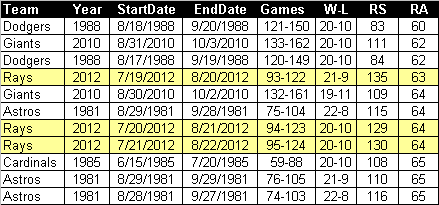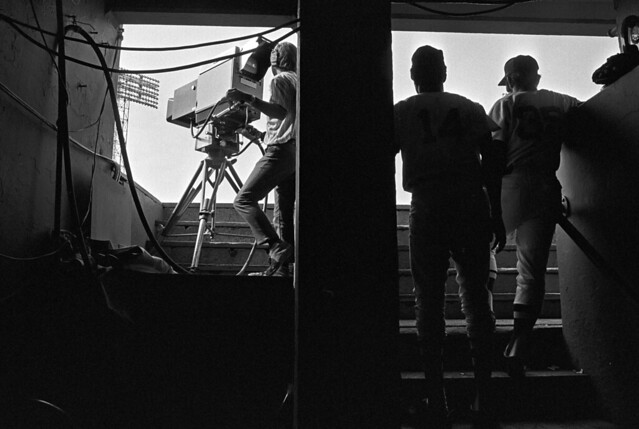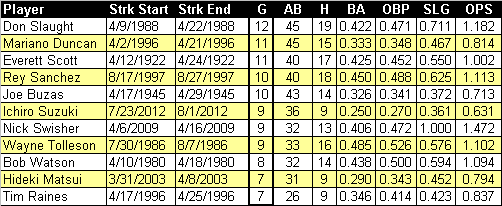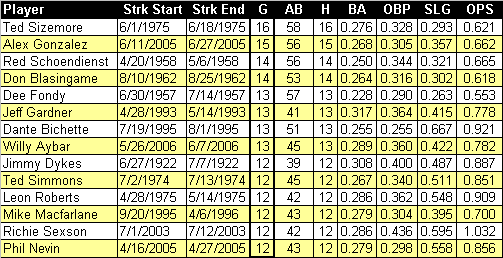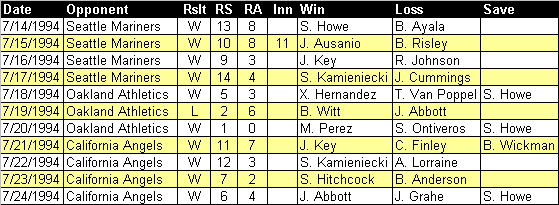
The American National Game of Baseball, 1866, Currier & Ives lithograph depicting Elysian Fields, Hoboken, New Jersey
After 14 straight losing seasons, the Baltimore Orioles finally clinched a winning campaign earlier in the week. Meanwhile, the Pittsburgh Pirates, who are sitting on 19 consecutive campaigns below .500, are desperately trying to do the same. Each team’s long run of futility has drawn a lot of attention, but on the flip side, the Yankees’ string of winning seasons has gone unnoticed.
Longest Consecutive Winning Season Streaks, By Franchise

Note: Data is as of 2011; blue bars represent NL; red bars represent AL.
Source: Baseball-reference.com
Most people take the Yankees’ success for granted, but with another winning season in the bag, the team now has 20 straight years with an above .500 record. During that span, the Bronx Bombers have compiled a regular season winning percentage of nearly .600 to complement five championships, seven AL pennants, and 12 division titles. The team’s recent struggles heading down the stretch in 2012 have obscured the franchise’s impressive run, but, nonetheless, the Yankees remain in the midst of a golden age.
The Yankees’ current stretch of 20 consecutive winning seasons is the second longest streak of its kind in baseball history. However, it’s a distant second. From 1926 to 1964, the Bronx Bombers reeled off 39 straight winning campaigns, including 18 championships, 25 pennants, and a victory in over 62% of all regular season games. No wonder the Yankees easily lead the majors with the highest percentage of winning seasons.
Winning Season Rates, By Franchise

Note: Includes 2012 season as of September 18, 2012.
Source: Baseball-reference.com
Aside from the Yankees’ two winning season streaks of 39 and 20, the Baltimore Orioles boast the next longest stretch, which lasted for 18 seasons from 1968 to 1985. The best run put forth by a National League team is shared by the Atlanta Braves and St. Louis Cardinals. The Braves enjoyed 15 straight winning seasons from 1991 to 2005, while the Cardinals run lasted from 1939 to 1953.
Current Season Streaks, By Franchise

Note: Data is as of 2011
Source: Baseball-reference.com
Among active streaks, the Yankees’ 20-year run is now double the combined total of the next two closest teams because the runner-up Red Sox’ 14 seasons in a row was snapped just two years short of the franchise record. The Cardinals and Rays, who each enter today’s action with 79 victories, are working toward five straight winning seasons, while the Rangers, Giants, and Braves have already notched their fourth consecutive above .500 campaign (with the Tigers also knocking on the door). Meanwhile, should the Pirates join the Orioles on the winning side of the equation, the Royals will take over the lead for the longest streak of losing seasons with nine.
Will this be the year the Pirates finally join the ranks of the winners? How much longer can the Yankees keep their current streak intact? When each team started their current streaks in 1993, the Yankees were coming off their franchise-high fourth straight losing season, while the Pirates were riding three consecutive division titles. In other words, the fortunes of any franchise can turn suddenly, so if there’s one lesson to be learned, fans should never take their team’s achievements for granted. Diamonds may be forever, but in baseball, success on the diamond is not.









